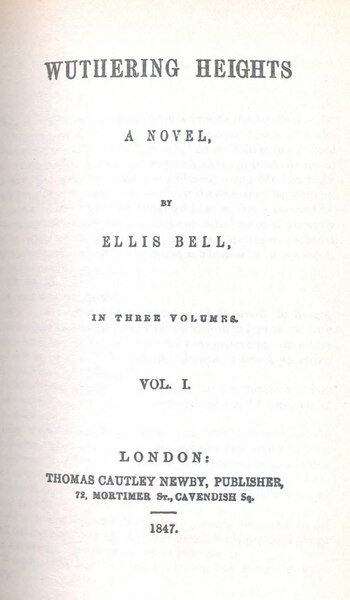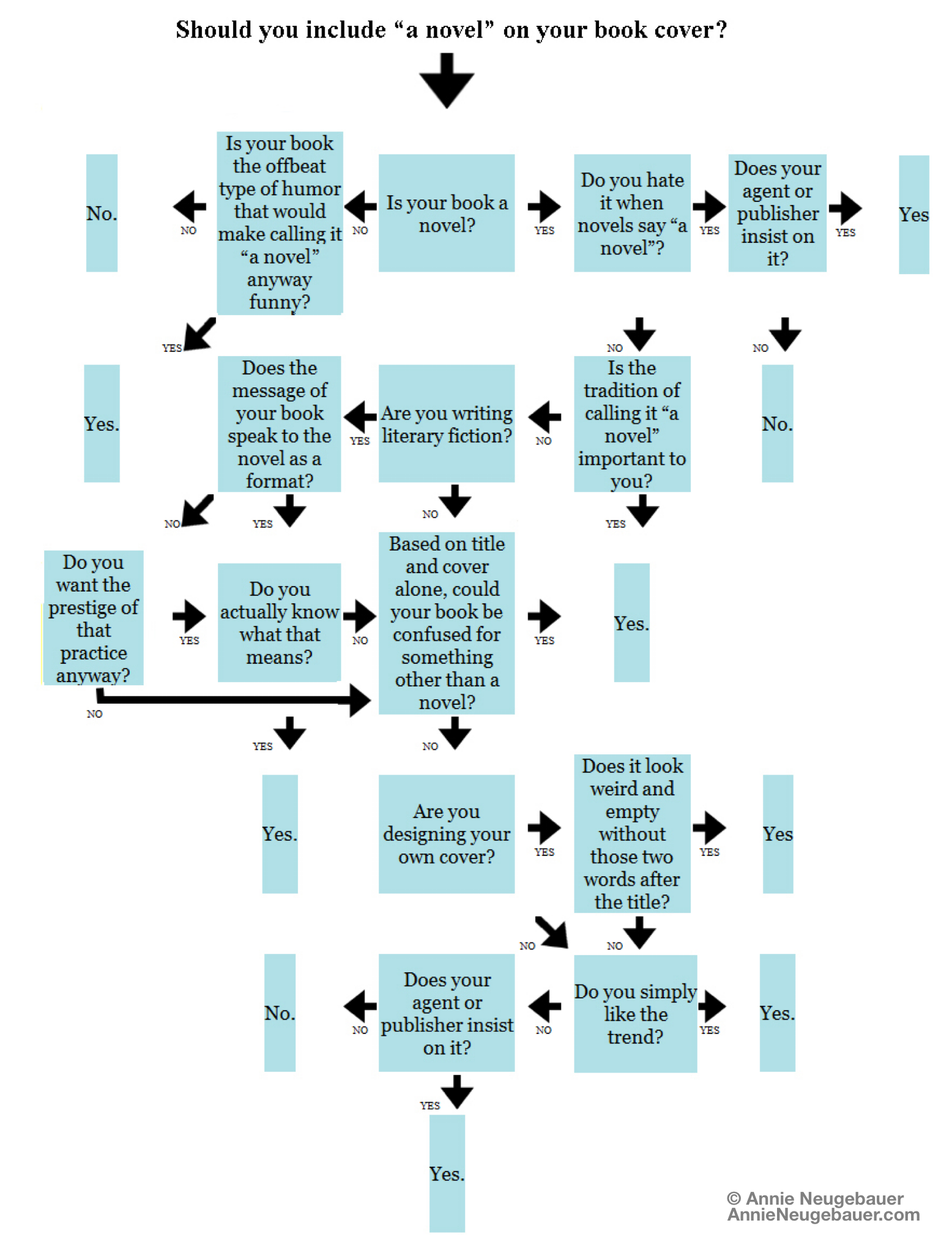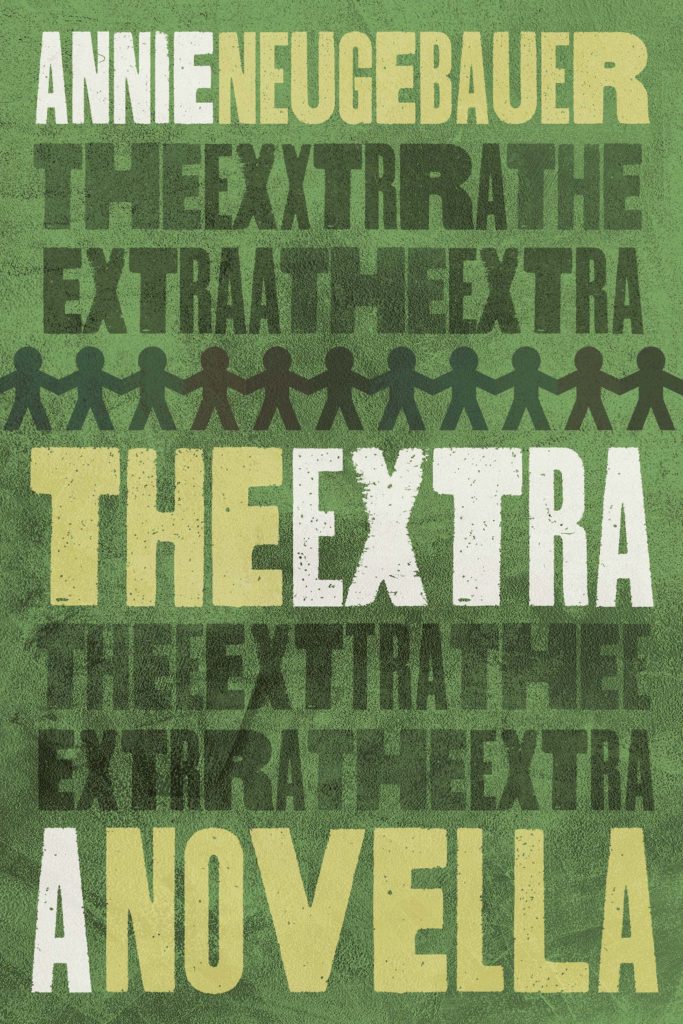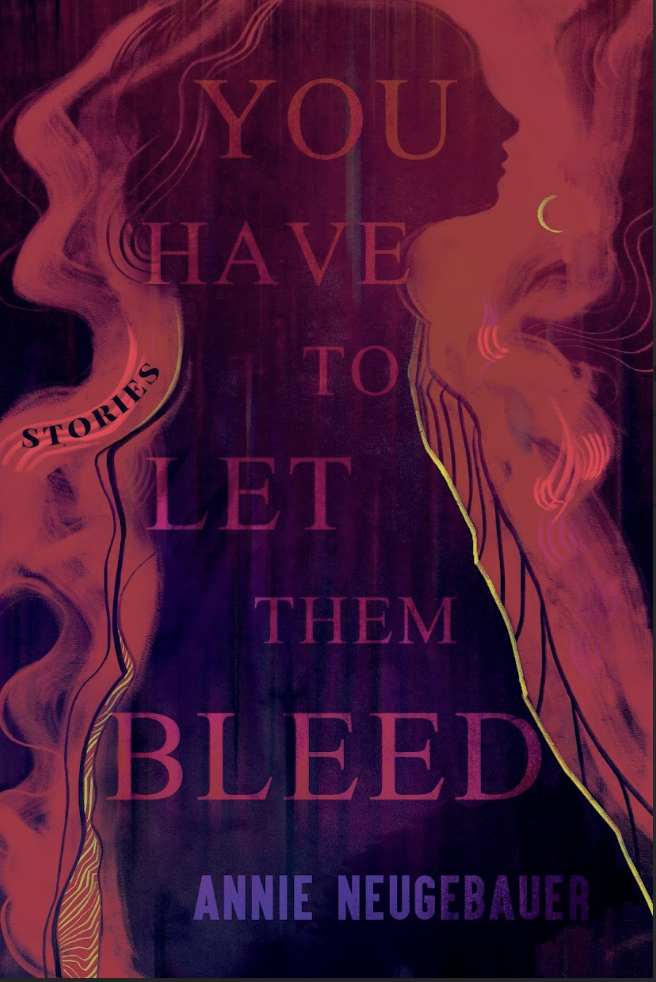Ever notice how some novels have “A Novel” written right on the cover, under the title? Maybe you have but haven’t thought about it. Or maybe it drives you insane. But if you tread in bookish enough circles, the subject will come up eventually.
The gist of it is… why? It seems obvious and redundant, possibly even snooty and declarative. Some people love it, some hate it, but no one seems to quite know why it’s done. I have some thoughts!
A Brief History
Now I’m not going to drag you through a complete history lesson of the novel, but I will say that as a literary format, it’s a relatively new invention. Lyrics, poetry, plays, journals, and essays are all much older. The novel, roughly recognizable as how we think of it today, didn’t gain any continuous popularity until the 18th century.
Take, for example, the first edition of Wuthering Heights.
You can see on the title page that it says “A novel by [Emily Brontë’s pen name]”. This was published in 1847. Nowadays, a book with this title would likely leave off “a novel” and shelve it under fiction. But that’s because for us, today, a novel is the default. (That format won the literary battle, for now. Hurrah, novels!) If we’re told to read “this really good book,” most of us will assume it’s a novel unless otherwise specified.
Back then, however, people were still assuming things were essays, memoirs, travel journals–not to mention that people didn’t just take a bus to the library or order something off Amazon, where the genre was clearly labeled on the shelf. So you can see that “a novel” under the title served a necessary function.
That’s all well and good, but now that “a novel” is pretty much the default these days, why has that little clarification stuck around? It isn’t cut and dry, but my best guess is that there are several reasons, often more than one at a time. I’m going to hit the highlights below, followed by a flow chart so you (if you’re a writer) can decide if you want those two little words on your book, too.
Reasons People Use it Now
Tradition– Tradition is a heady thing. Wedding vows, national symbols, school colors: our lives are steeped in it. There’s something powerful about tapping into an experience or symbol that generations before have also experienced. In one way, it makes us feel more grounded, more connected to the past. It can also be a way of acknowledging one’s lineage, tipping the hat to those who paved the way. Tradition is in most facets of our lives. Why should literature be the exception?
Literary device– Remember how literary fiction uses devices outside of plot and character to send a message? Sometimes (more often than you might think) that message involves literary history, the act of writing, the art of storytelling, the format of words… in short, it involves novels themselves. In this case, literary context becomes a device. Which is part of why you see “a novel” on so many works of literary fiction, specifically. Those two words are already communicating with you; they’re setting you into the frame of mind to understand the message.
Prestige– And because literary fiction authors have used “a novel” often enough as a literary device for it to become noticeable… no doubt there have been other authors simply trying to cash in on this association. Literary fiction has quite a bit of prestige in some circles, and those who want in might use this to their advantage. Now, who’s doing it to further their message and who’s doing it to add some clout to their name is subjective.
Clarity– Is Eat, Pray, Love, a memoir, a self-help book, or a novel? You know if you’ve read it, but if you haven’t… you really might not. What about Goodbye, Columbus? How about A Thousand Mornings? Even Who’s Your Mama, Are You Catholic and Can You Make a Roux?* If an author (or publisher) is worried that the book could be misinterpreted from the title and cover alone, they might stick “a novel” on there just to be safe. With the growing prominence of online purchasing–where genres are a tag down at the bottom rather than a shelf you walk up to–this is not necessarily a paranoid choice.
Assertion– On a related note, have you ever noticed that many experimental novels have “a novel” on the front? It’s almost like they’re saying, “I know I messed with some things, but, really, this is a novel; I promise.”
Layout– I really think that designers sometimes include these two little words to help visually balance the layout of the cover. Length of the title, size and sharpness of the images/background, plus length of the author’s name all affect how a cover looks, and sometimes adding two words in the middle might help. Don’t knock it. These things matter. (Maybe not to you, but to someone.)
Trend– And, finally, the obvious one. The one that most likely accounts for 80% of current books that say “a novel” on the cover: It’s in style! And scoff at that all you want, but covers, titles, even genres come and go over the years; this is just another bit of choice that adds flavor to a book.
*(The answers, in order, are: memoir, novel, book of poetry, cookbook.)Authors, Need Help Deciding?
This might help get you started. (Y’all have no idea how long this took me.) Click chart to enlarge.
So, what do you think about this practice?
Authors, did you include “a novel” on your book? Writers, do you plan to?
Share this:





I was looking at one of those Best Books of 2012 lists. Nearly every title included the addition of “A Novel” at the end. One, two, or even five on the list with that designation probably wouldn’t have been that noticeable. But nearly all of them? I started laughing. It just felt so ridiculous, like I’d wandered onto the set of Frasier or into a Saturday Night Live skit. I wondered if that list said something about the list-maker or about the writers on it.
But your explanation of the why’s is wonderful. I can see now that there might be good reasons to include “A Novel” in a book title. Still, when it is in every book title it does start to become sort of too cute.
Yes, a lot of people feel that way right now, Regina. Essentially, it’s saturation of the trend — as evidenced by your experience. What’s always interesting, though, is to see if a trend (any trend, including this one) fades and gives way to a different trend or becomes a staple. With so many books already doing it, it might just become “the norm.” Maybe in a year or two we’ll hardly notice it! …Or maybe we’ll all get sick of it and no one will do it anymore. 🙂
I LOVE your chart. So great!
For some reason I really like it when books say A Novel, probably just because of my preference for the format. But you’re right that it tends to be something used for more literary novels. And in some cases, I think it helps when the title works for the book, but perhaps doesn’t give off that “literary” vibe. For example, I see a lot of short, one-word titles doing this. I think it has a nice ring to it, in general 😉
Thanks Natalia! Considering how much time I wasted piddling around with that chart, I’m glad to hear someone like it. =D And yes, the one-word title is a great example! Sort of clarity, device/prestige, layout, and trend all in one. I agree that the one-word ones sound especially smooth. I even sometimes see them with a colon and “a novel” *in* the title instead of beneath it, like this: “Burn: A Novel.”
It’s an infographic flowchart! (I love flowcharts!) And “Do you actually know what that means?” lol!
Well, I am a fan of “a novel”, seeing as how I put it on mine and I tend to read books that have it as well. But to expand upon the “clarity” reasoning, with the rise of shorter-length publishing, especially in ebooks where you can’t physically pick up the book to judge it’s length, sometimes “a novel” is added for clarity in that regard. I plan on publishing at all sorts of different lengths, so I imagine after the first, it’ll be useful for my readers to know if they’re getting a novel, a novella, or a short story. One of the biggest complaints you’ll see in short story reviews is always: “That was so short! I didn’t know it was going to be so short!” So authors really do need that additional bit of clarity there, if only to save themselves from one-star reviews.
This was a very interesting topic! My first was a novel with a very novel-like title, so it probably wasn’t necessary for me to include “a novel”, but in the overall scope of my work, I think it’ll be useful. And besides, I’m one of those literary types who just likes it! 😉
Hehe, thanks Laura. And that is a WONDERFUL point about clarity of length. In that case, “a novel” becomes more like “a short story” or a “novella” in that the author is explaining to the reader how much they’re getting (and often, why the work is priced the way it is). I too have seen angry readers who though a short was going to be a full novel, so I think you’re spot on there.
And as you know, I adore your book cover and title for EWTF, and that includes “a novel” on there. I love the size of it and how it fits in the niche created by the F’s stem. So yes, I suppose I’m a fan of this practice too, when done well. =)
I included it on the cover of my book for clarity. “NINE DAYS: Uncertainty, passion and destiny in the crucible of America’s culture war” could possibly be mistaken for a political treatise. I didn’t want to take that chance. AND, I admit I was also influenced by the trend since like half the novels today seem to have it somewhere on the cover.
Yes, I agree that title could be read as something other than a novel title, so I think you made a wise choice!
Oooh. I love this post. I’ve always wondered why some novel say “a novel”– and you prompted me to pull out the favorites from my shelf, nearly ALL of which say “a novel.” So, either I’m reading all literary fiction, or it’s simply been the trendy thing to do since 2009 (most of my faves start around that point, because that’s when I started “keeping” my books and not giving them all away). At any rate, I think I DO want “a novel” on the front of my book baby. I like tradition, and hell yes – I’d love to be considered ‘literary’. Who wouldn’t?
By the way … my brain hurt just following the flow chart. I can’t IMAGINE creating it (and appreciate all your efforts!). I’m oh-so-impressed!
Thanks! As to your faves… it’s probably a little bit of both! I definitely see “a novel” being on your book, from what I know if it. And I’m glad you’re impressed by the chart; that means my time was less “wasted” and more “spent.” Or that’s what I’m telling myself. 😉
I’ve often wondered about the inclusion of “A Novel” and you clarified things quite nicely. I knew I started stalk…uh following you for a good reason. 🙂
Aw, haha! Thanks Missy!
mm flowchart. I approve of this post! Someone needs to make a flowchart of a flowchart.
Loved this post!
A flowchart flowchart? That’s love. I don’t think I have it in me. Heh. Thanks Febe!!
I don’t mind “a novel.” It does let me know right away what I’m looking at in cases where the title is unfamiliar. I assumed that’s why it was there.
I’m SO impressed with your decision flow chart. I’ve tried to do these (for goofy reasons) and I never can get past the first couple of things. I’m forever dead-ending… or confusing myself. Which sadly isn’t that hard for me to do. 😉
Trust me, you weren’t alone in being confused and dead-ending. Those things are nightmares. As I was telling Melissa, I spent hours on mine just to make it function, and I don’t even think it looks pretty. That’s a long time to spend on something not even pretty, lol!
Your information is always so fascinating, Annie! I’ll just up and admit, despite having been given so much insight into the practice, I still don’t entirely feel the trend. Then again, I never really got past the point in my life where I will just keep wanting to know, “Yeah, but why?” XD I think, at this stage, I will generally view anyone choosing to use A Novel as something they appreciate on some personal level which I don’t have access to. Works for all involved, that way.
~Ashlee
http://ashleesch.com
http://thedamningmoths.com
Thank you, Ashlee! You know, there’s no forcing taste! If you don’t like it, you don’t like it; I don’t see anything wrong with that. =)
One can also use “A [series name] Novel” to make sure people know that the book is part of a series. I’m planning to do this with a sequel I’m editing.
True! Good point!
I have wondered and wondered about “a novel”! Finally, today was the day I googled it! Your page was the first in the list of the topic. I can only say, as I pondered the question, why didn’t I stop and compare books with and without “a novel”! Thanks for explaining the mystery!!
My pleasure! And thanks for stopping by the comments and letting me know you were here. =)
Honestly, I find this trend so repulsive that I am boycotting any book that has “A Novel” on the cover. Words cannot express how much it disgusts me.
Those are very strong feelings!
I have been wondering about this “A novel” thing for ages! Finally googled it and found your piece here. I find it a bit redundant and annoying many times as a ‘sort of’ title tag/subtitle – like I might be too dumb to know what I’m reading, so they state the obvious.
I’m glad you found me! I can see what you mean, but I don’t think that’s how they intend it. Especially with the rise of digital book-selling, titles aren’t always “shelved” by genre anymore, so one person who starts out browsing novels might end up looking at a nonfiction title without realizing it. On the other hand, I also think many cover designers use it to fill empty space.
https://uploads.disquscdn.com/images/eacdc43e6047ea36d91269bae16ac3348e89c10c06d7a8993ef0f1162275c665.jpg
Dear Annie, I was looking for an answer to this deeply existential and puzzling question, and found your answer. And here is another flowchart, and you’ll have no idea how little ‘time this took me!’
Haha, this is great! Put a big smile on my face this morning. Thank you! 😀
whoo, one more! Was she polite and thankful in response?
I wanted someone to acknowledge all the work you put in on far more than just the graphic – maybe graphic novels (see step three) – and this seemed a little token of thanks for all your effort to help others. Even if I hate and don’t read (i.e. don’t ‘appreciate’) the whole horror genre. Have a great day 🙂
Hey, I’m the first to say horror’s not for everyone — no worries there! I appreciate your appreciation — and the fun you brought to my morning. You have a great day too!
Pingback: 233. jönnek a nadrágok adás | Hármas könyvelés